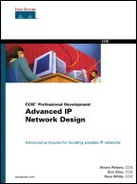Chapter 3. Redundancy
A single point of failure is any device, interface on a device, or link that can isolate users from the services they depend on if it fails. Networks that follow a strong, hierarchical model tend to have many single points of failure because of the emphasis on summarization points and clean points of entry between the network layers. For example, in a strict hierarchical network, such as the one depicted in Figure 3-1, every device and every link is a single point of failure.
Figure 3-1. Every Device and Link in This Network Is a Single Point of Failure

However, this network will be safe if it's protected by dial backup. Redundancy can save the day.
Redundancy provides alternate paths around these failure points, providing some measure of safety against loss of service. Be careful, though: Redundancy, if not designed and implemented properly, can cause more trouble than it is worth. Each redundant link and each redundant connection point in a network weakens the hierarchy and reduces stability.
How do you implement redundant designs without destroying your network's stability? First, start with some issues, strategies, and design goals and then examine redundant designs in each layer of the hierarchical model.
